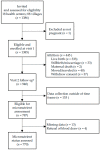Micronutrient Status among Pregnant Women in Zinder, Niger and Risk Factors Associated with Deficiency
- PMID: 28445440
- PMCID: PMC5452160
- DOI: 10.3390/nu9050430
Micronutrient Status among Pregnant Women in Zinder, Niger and Risk Factors Associated with Deficiency
Abstract
Anemia and micronutrient (MN) deficiencies in pregnant women are associated with adverse pregnancy outcomes. In Niger, 58.6% of pregnant women are anemic; however, MN statuses are unknown. The study objectives were to estimate the prevalence of MN deficiencies among pregnant women in Zinder, Niger and explore associated risk factors. Pregnant women living in randomly selected rural villages (n = 88) were included. Capillary and venous blood samples (n = 770) were analyzed for hemoglobin (Hb) and plasma ferritin, soluble transferrin receptor (sTfR), zinc (pZn), retinol binding protein (RBP), folate and vitamin B12. C-reactive protein and alpha-1-acid glycoprotein were measured to adjust for inflammation. The prevalence of MN deficiencies in pregnant woman was high, indicative of a severe public health problem. Prevalence of iron deficiency was 20.7% and 35.7%, by ferritin (<15 µg/L) and sTfR (>8.3 mg/L), respectively. In total, 40.7% of women had low pZn (<50 µg/dL), 79.7% had marginal RBP (<1.32 µmol/L), 44.3% of women had low folate (<10 nmol/L) and 34.8% had low B12 concentrations (<148 pmol/L). Common risk factors associated with MN status included gravidity, mid-upper-arm circumference, geophagy, malaria, and result of the woman's last pregnancy. Interventions to promote the strengthening of antenatal care, and access and adherence to nutrition and health interventions are critical among pregnant women in this population.
Keywords: anemia; antenatal care; deficiency; iron; micronutrient; pregnancy; vitamin; zinc.
Conflict of interest statement
The authors declare no conflict of interest. The founding sponsors had no role in the design of the study; in the collection, analyses, or interpretation of data; in the writing of the manuscript, and in the decision to publish the results.
Figures
Similar articles
-
Prevalence of multiple micronutrient deficiencies amongst pregnant women in a rural area of Haryana.Indian J Pediatr. 2004 Nov;71(11):1007-14. doi: 10.1007/BF02828117. Indian J Pediatr. 2004. PMID: 15572822 Review.
-
Genetic hemoglobin disorders rather than iron deficiency are a major predictor of hemoglobin concentration in women of reproductive age in rural prey Veng, Cambodia.J Nutr. 2015 Jan;145(1):134-42. doi: 10.3945/jn.114.198945. Epub 2014 Nov 19. J Nutr. 2015. PMID: 25527668
-
Multiple micronutrient status and predictors of anemia in young children aged 12-23 months living in New Delhi, India.PLoS One. 2019 Feb 8;14(2):e0209564. doi: 10.1371/journal.pone.0209564. eCollection 2019. PLoS One. 2019. PMID: 30735503 Free PMC article.
-
Asymptomatic malaria infection affects the interpretation of biomarkers of iron and vitamin A status, even after adjusting for systemic inflammation, but does not affect plasma zinc concentrations among young children in Burkina Faso.J Nutr. 2014 Dec;144(12):2050-8. doi: 10.3945/jn.114.200345. Epub 2014 Oct 1. J Nutr. 2014. PMID: 25411038
-
Methodologic approach for the Biomarkers Reflecting Inflammation and Nutritional Determinants of Anemia (BRINDA) project.Am J Clin Nutr. 2017 Jul;106(Suppl 1):333S-347S. doi: 10.3945/ajcn.116.142273. Epub 2017 Jun 14. Am J Clin Nutr. 2017. PMID: 28615254 Free PMC article. Review.
Cited by
-
Teff consumption and anemia in pregnant Ethiopian women: a case-control study.Eur J Nutr. 2019 Aug;58(5):2011-2018. doi: 10.1007/s00394-018-1759-1. Epub 2018 Jun 23. Eur J Nutr. 2019. PMID: 29936535
-
Prevalence of and risk factors for iron deficiency among pregnant women with moderate or severe anaemia in Nigeria: a cross-sectional study.BMC Pregnancy Childbirth. 2024 Jan 5;24(1):39. doi: 10.1186/s12884-023-06169-1. BMC Pregnancy Childbirth. 2024. PMID: 38182997 Free PMC article.
-
Prevalence, types and determinants of anemia among pregnant women in Sudan: a systematic review and meta-analysis.BMC Hematol. 2018 Nov 8;18:31. doi: 10.1186/s12878-018-0124-1. eCollection 2018. BMC Hematol. 2018. PMID: 30455961 Free PMC article.
-
The mixed effects of a package of multilevel interventions on the health and care of pregnant women in Zinder, Niger.BMJ Glob Health. 2019 Dec 10;4(6):e001200. doi: 10.1136/bmjgh-2018-001200. eCollection 2019. BMJ Glob Health. 2019. PMID: 31908852 Free PMC article.
-
Integrating nutrition into health systems at community level: Impact evaluation of the community-based maternal and neonatal health and nutrition projects in Ethiopia, Kenya, and Senegal.Matern Child Nutr. 2018 Feb;14 Suppl 1(Suppl 1):e12577. doi: 10.1111/mcn.12577. Matern Child Nutr. 2018. PMID: 29493902 Free PMC article.
References
-
- Black R.E., Victora C.G., Walker S.P., Bhutta Z.A., Christian P., de Onis M., Ezzati M., Grantham-McGregor S., Katz J., Martorell R., et al. Maternal and child undernutrition and overweight in low-income and middle-income countries. Lancet. 2013;382:427–451. doi: 10.1016/S0140-6736(13)60937-X. - DOI - PubMed
-
- Mori R., Ota E., Middleton P., Tobe-Gai R., Mahomed K., Bhutta Z.A. Zinc supplementation for improving pregnancy and infant outcome. Cochrane Database Syst. Rev. 2012;2:CD000230. - PubMed
-
- Stevens G.A., Finucane M.M., De-Regil L.M., Paciorek C.J., Flaxman S.R., Branca F., Peña-Rosas J.P., Bhutta Z.A., Ezzati M. Global, regional, and national trends in haemoglobin concentration and prevalence of total and severe anaemia in children and pregnant and non-pregnant women for 1995-2011: A systematic analysis of population-representative data. Lancet Glob. Health. 2013;1:e16–e25. doi: 10.1016/S2214-109X(13)70001-9. - DOI - PMC - PubMed
MeSH terms
Substances
LinkOut - more resources
Full Text Sources
Other Literature Sources
Medical
Research Materials


